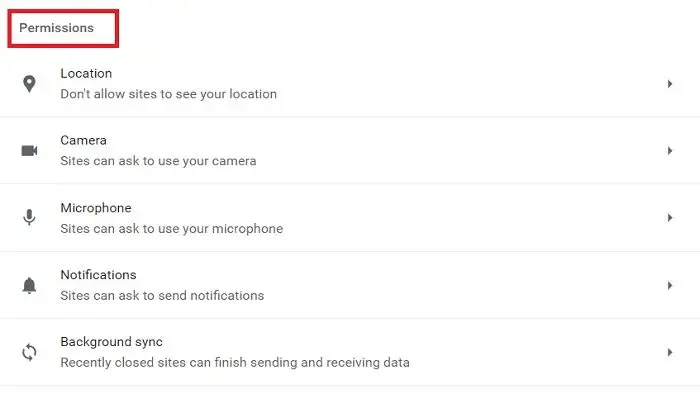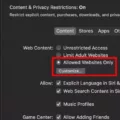When it comes to protecting your data and privacy online, understanding website permissions is key. Knowing what each permission does and how it affects your browsing experience can help ensure that you’re not giving away more information than necessary.
What are website permissions? Website permissions are the settings that websites require in order to work properly. These can include access to a device’s microphone, location, camera, and more. Website permissions also determine whether or not pop-ups will be shown. By allowing these permissions, you are allowing the website to access certain information from your device.
How do I manage website permissions? On desktop browsers such as Chrome and Firefox, you can manage website permissions by going into the browser settings. Select “Permissions” and then choose which websites you want to grant access to certain features on your computer or device. On mobile devices like Android, you can go into the Chrome app and select the three-dot icon in the upper right corner of your screen. Scroll down to the “Advanced” section and tap “Site settings” to manage all of your website permissions at once.
What happens if I don’t allow website permissions? If you don’t allow certain website permissions, then some features on certain websites might not work properly for you or at all. Additionally, blocking cookies or other data types may improve your privacy but could also lead to an overall worse browsing experience because some websites rely on these types of data in order to work correctly.
By understanding what website permissions are, how they affect our online experience, and how we can manage them appropriately, we can stay safe while still getting the full online experience we desire.

Resetting Site Permissions
Resetting site permissions means resetting all the settings that websites require to be able to access certain features on your computer. This includes permissions for accessing your microphone, location, camera, showing pop-ups, and more. When you reset these settings, all existing site permissions will be set back to their default state. This gives you the chance to make sure that you are allowing only trusted websites access to these features on your computer or device.
Viewing Chrome Site Permissions
Chrome site permissions can be found by tapping the three-dot icon in the upper right-hand corner of your Chrome app screen. From there, scroll down to the Advanced section and select Site settings. This will bring you to a page where you can manage any permissions associated with individual websites.
Unblocking Blocked Sites on Chrome
To open blocked sites on Chrome, you’ll need to change your browser’s settings. Here are the steps to follow:
1. Open the Chrome app on your device.
2. Select the More option (three vertical dots) on the right side of your screen.
3. Click on Settings.
4. Go to Privacy and Security in the left sidebar menu.
5. Select Site Settings from the available options.
6. Scroll down and find Blocked Sites, then check for a list of blocked websites or add a new website if needed.
7. Unblock your desired website by selecting the switch next to it so it is set to ‘on’.
8. Once you’ve made any necessary changes, click Done at the bottom of the page to save and apply your changes for that site or sites you’ve unblocked.
Chrome Permissions
Chrome permissions give users control over what content they grant websites access to on their devices. Depending on the website, there are a few different permissions that may be requested: cookies and site data, location, camera, microphone, motion sensors, notifications, JavaScript, and Flash.
Cookies and site data are used to store information about the user’s browsing habits and preferences so the website can remember them when they revisit them. Location permission allows websites to access the user’s location information. Camera permission grants access to the user’s webcam for taking pictures or recording video. Microphone permission gives websites access to the computer’s audio recording capabilities. Motion sensor permission enables sites to detect movement from devices like phones or tablets and use it as input for games or other activities. Notification permission lets websites send notifications that appear in the corner of the user’s screen. JavaScript is a programming language that powers many dynamic features on web pages. Flash is a multimedia platform used for animations and videos on some websites.
Chrome users should only grant permissions when they trust the website involved; otherwise, they should deny access or leave the page without granting any permissions at all.
Checking Browser Permissions
To check your browser permissions, you will first need to open your browser. At the top right of the page, click on the ‘More’ button and select ‘Settings’ from the drop-down menu. Once in settings, look for the ‘Privacy and Security’ heading and click on ‘Site Settings’. On this page, you can view all of your browser permissions such as Camera, Cookies, Location, Popups, and more. To adjust any permission settings, simply click on it to expand a menu of options. Here you can enable or disable certain settings or customize them further by using the toggle switches.
Conclusion
In conclusion, site permissions are a necessary element of controlling how websites interact with the user. It is important to regularly review the settings in order to ensure that only those sites that are trusted are given access to certain features such as microphone, location, and camera. Additionally, deleting browsing data such as cookies and cached images can help protect the privacy and improve website performance. Lastly, ensuring that desired websites are unblocked can allow for a more secure browsing experience.








